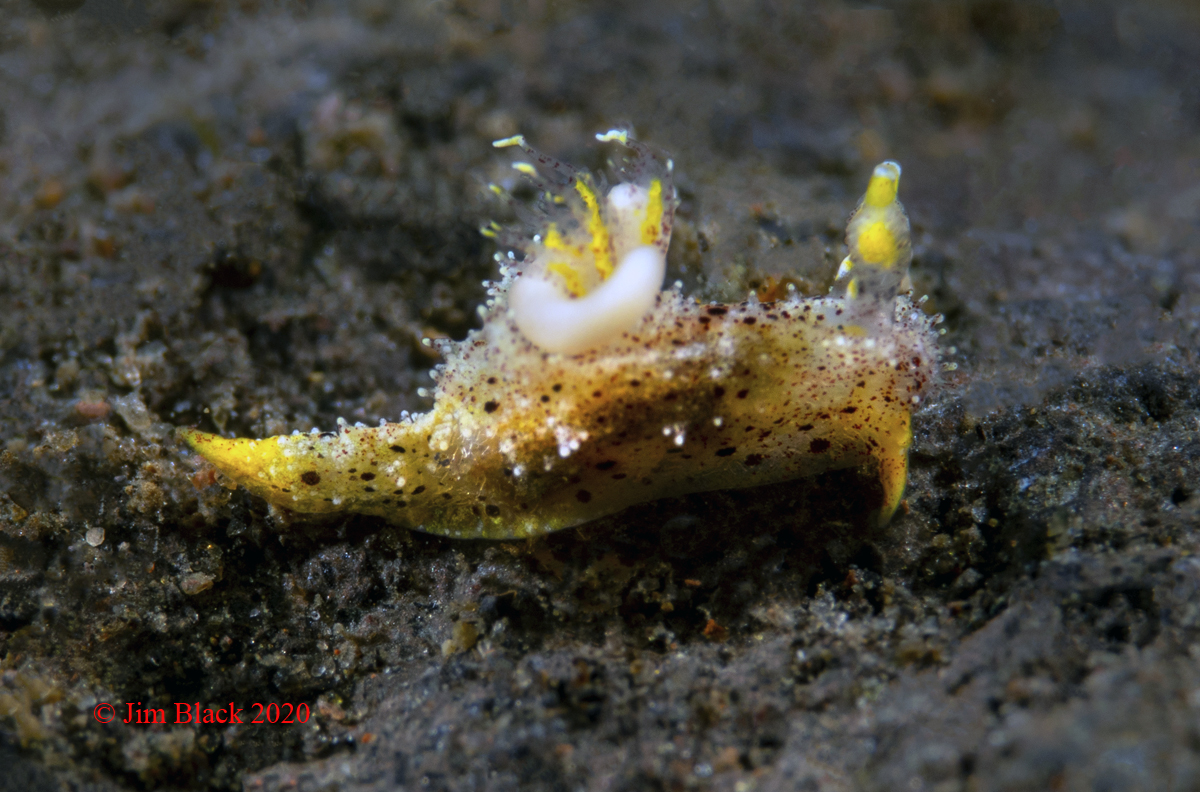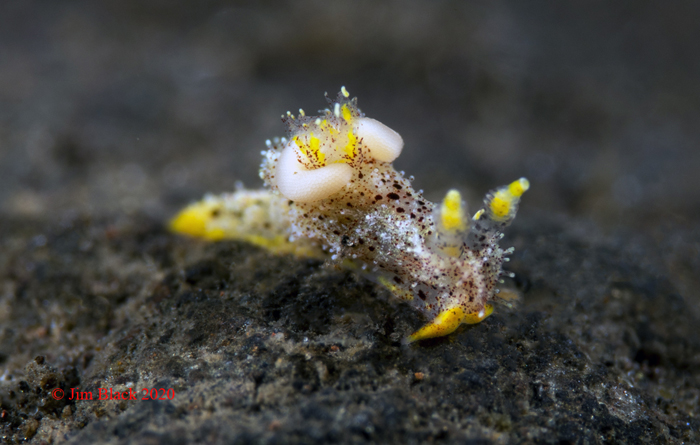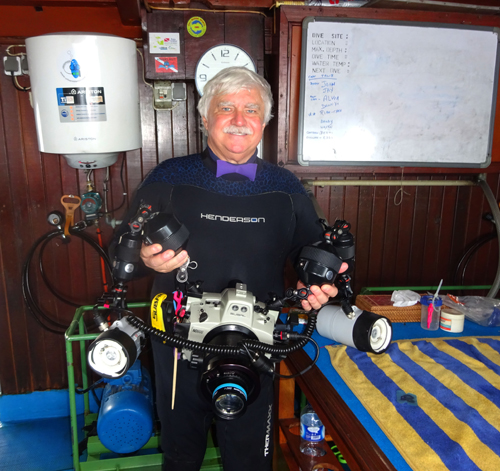 |
Polycera sp. 4
Image courtesy of Jim Black
Villa Markisa Dive resort , Tulumben, Bali, Indonesia
Jan. 2020
 |
Polycera sp. 4 (undescriibed) Took me a while to figure is guy out. After much sleuthing I stumbled across Polycera sp. 4 in NSSI 2nd Edition. While Jim's critter here looks very different from Terry's photo in NSSI, there are adequate similarities to make the call. I believe (and Terry agrees) that Jim's critter is just a super colorful variation. Note the consistent dark brown spots, and the morphology and coloration of the thin yet tall tubercles on the body. In Jim's photo above you can clearly see this characteristic on the tubercles on the head. The specimen in NSSI is tan with brown spots, differing from Jim's bright yellow specimen. Also of note are the bright yellow rhinophores and gill. This is good color variation information to add to our description of the beast. Not part of the slug's anatomy is the large white pillow circling the gill. This is the egg mass of a parasitic copepod, the head of which is buried deep in the slugs gill cavity. Parasites like this affect their host in several ways, most commonly altering the reproductive performance of the host - sterilizing it. This species is now documented from Papua New Guinea, Japan and Indonesia. |
Sammamish, WA 98074
May., 2020
Send Dave email at davidwbehrens@gmail.com
Jim on location at Raja Ampat, 2017
 |
Jim Black Retired from US Airways, and now after a merger, American Airlines with 37 years service as a pilot. Jim retired as Captain flying an A330 Airbus Internationally. Diving since 1970, with close to 8000 dives now. Currently shooting a NIkon D800E in a Subal Housing with Ikelite strobes.. Jim uses a Macro Mate, and a Nauticam SMC and its Multiplier for super macro work. Jim's photography has been featured in a number of books and publications including Helmut Debelius' Nudibranchs and Sea Snails of Gosliner, Behrens and Williams Coral Reef Animals of the Indo-Pacific. A photo of Jim petting a shark in "Sleeping Shark Caves" off Isla Mujeres Island, Mexico, taken by Amy Foster his significant other, recently appeared in Dave Behrens' Diving Guide to Cozumel, Cancun & The Riviera Maja. Jim has also been a major contributor to (1) the New Indo-Pacific Nudibranch and Sea Slug Identification book by Gosliner, Valdez, Behrens (NSSI),(2) Tropical Pacific Reef Creature Identification by Humann & DeLoach,(3) Nudibranchs Encyclopedia by Neville Coleman,(4) Reef Fishes of the East Indies by Gerald Allen and Mark Erdmann, And many other publications. Jim has been a solid supporter of the Slug Site since day one. His countless contributions put him near the top of the list of photographers who have greatly expanded our knowledge of sea slugs. There are a lot of kids in the formative stage of their education who are getting their first introduction to our sea slug friends via the great photographs Jim and other contributors have made to the site. My hat is off to Jim for making this presentation possible!
Send Jim email at jim.black14@verizon.net
|

Attention all you Sluggers, and you know who you are! The NSSI 2nd edition is available in ebook PDF and book form . The hard back version will become available Nov. 1st. Both will cost $65 (individually). You will need to jump through a few hoops to get the electronic version as pdf distribution is protected by Adobe ID!! Please read the following to enable reading your electronic purchase! This new 2nd Edition is updated and reorganized, including 185 new species. Among other features, the new edition includes additional photographs of species, an identification key, and an up-to-date classification reflecting the latest evolutionary relationships. The Indo-Pacific represents the largest expanse of tropical ocean in the world, stretching from the Indian Ocean coast of southern Africa and the Red Sea to the central Pacific of the Hawaiian Islands, Easter Island and the Marquesas. This region supports the most diverse marine fauna of any place in the world for most groups of marine organisms. The nudibranchs and sea slugs are no exception to this rule; there are about 3,000 described species of these organisms in the world and at least 40% of these have been found exclusively in the Indo-Pacific tropics. This book illustrates 2,138 Indo-Pacific nudibranchs and sea slugs, including many undescribed species.
|

|
